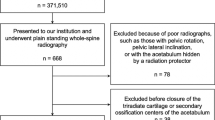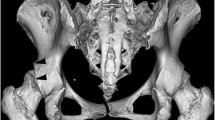Abstract
Background
The angle formed by the intersection of the line between triradiate cartilage of both hips (Hilgenreiner’s line) and a line drawn between triradiate cartilage and the external roof of the acetabulum is called the acetabular index (AI), the angle formed by line of proximal femoral physis and middiaphysis axis of femur is called the epiphyseal angle (EA). Both decrease with age, but it is not described whether there is a relation between them in this development. It would be very useful to compare its evolution in children with normal hips, in order to compare them with displasic hips in the same groups of age.
Objective
To study the radiographic angles and the relationship between the acetabulum and the proximal femur.
Materials and methods
Retrospective study was performed on pelvic X-rays in 224 children between 1 and 3 years of age. Children with injuries, sepsis or inflammatory disease were excluded. We measured by goniometer (error ±1°): the AI, and the angle of the proximal femoral physis (EA). We have compared statistically the parameters.
Results
The AI was 21.1° (±3.8), 19.9° (±3.5), and 16.1° (±4.2) and EA was 75.8° (±5.1), 75.9° (±6.3), and 75.6° (±4.7), at the ages of 1, 2, and 3 years, respectively. A significant difference was noted for AI between 2 and 3 years old (P = 0.003), but there was not significative EA decrease. No significant correlation was found between AI and EA among the different groups, nor overall (r = 0.03). Sex or side was not a significant factor for both angles.
Conclusion
The AI decreases significantly between 1 and 3 years of age, but not the EA. No significant relation was found between them in the different age groups. Normal children’s hips have a tendency to spontaneously improve its acetabular morphology during the first 3 years of life.


Similar content being viewed by others
References
Albinana J, Dolan LA, Sprant KF et al (2004) Acetabular dysplasia after treatment for developmental dysplasia of the hip. J Bone Joint Surg 86B:876–886
Billing L, Bogren HG, Tallin J (2002) Reliable X-ray diagnosis of slipped capital femoral epiphysis by combining the conventional and a new simplified geometrical method. Pediatr Radiol 32:423–430
Boniforti FG, Fujii G, Angliss RD, Benson MD (1997) The reliability of measurements of pelvic radiographs in infants. J Bone Joint Surg 79B:570–575
Broughton NS, Brougham DI, Cole WG, Menelaus MB (1989) Reliability of radiological measurement in the assessment of the child’s hip. J Bone Joint Surg 71 B:6–8
Chung SMK, Batterman SC, Brighton CT (1976) Shear strength of the human femoral capital epiphyseal plate. J Bone Joint Surg 58 A:94–103
Garvey M, Donoghue VB, Gorman WA, O’Brien N, Murphy JF (1992) Radiographic screening at four months of infants at risk for congenital hip dislocation. J Bone Joint Surg 74B:704–707
Greco F, de Palma L, Specchia N, Mannarini M (1989) Growth-plate cartilage metabolic response to mechanical stress. J Pediatr Orthop 9:520–524
Grissom L, Harcke HT, Thacker M (2008) Imaging in the surgical management of developmental dislocation of the hip. Clin Orthop 466:791–801
Haraldsson S (1968) The epiphyseal angle in coxa vara infantum and its relation to results. Acta Orthop Scand 39:76–81
Harris NH (1976) Acetabular growth potential in congenital dislocation on the hip and some factors upon which it may depend. Clin Orthop 119:99–106
Heimkes B, Posel P, Plitz W, Jansson V (1993) Forces acting on the juvenile hip in the one-legged stance. J Pediatr Orthop 13:431–436
Hughes L, Aronson J, Smith S (1999) Normal radiographic values for cartilage thickness and physeal angle in pediatric hip. J Pediatr Orthop 19:443–448
Kay RM, Jaki KA, Skaggs DL (2000) The effect of femoral rotation on the projected femoral neck-shaft angle. J Pediatr Orthop 20:736–739
Kuklo TR, Potter BK, Schroeder TM, O’Brien MF (2006) Comparison of manual and digital measurements in adolescent idiopathic scoliosis. Spine 31:1240–1246
Kummer B (1993) Is the Pawels’ theory of hip biomechanics still valid? A critical analysis based on modern methods. Ann Anat 175:203–210
Loder RT, Spiegel D, Gutknecht S, Kleist K, Ly T, Mehbod A (2004) The assessment of intraobserver error in the measurement of noncongenital scoliosis in ≤10 years of age. Spine 29:2548–2553
Mirkopulos N, Weiner DS, Askew M (1988) The evolving slope of the femoral growth plate relationship to slipped capital femoral epiphysis. J Pediatr Orthop 8:268–273
Mitchell PD, Chew NS, Goutos I, Hebly EC, Lee JC, Evans S, Hulme A (2007) The value of MRI undertaken immediately after reduction of the hip as a predictor of long-term acetabular dysplasia. J Bone Joint Surg 89B:948–952
Mladenov K, Dora C, Wicart P, Seringe R (2002) Natural history of hips with borderline acetabular index and acetabular dysplasia in infants. J Pediatr Orthop 22:607–612
Öguz Ö (1996) Measurement and relationship of the inclination angle, Alsberg angle and the angle between the anatomical and mechanical axes of the femur in males. Surg Radiol Anat 18:29–31
Paton RW, Srinivasan MS, Shah B, Hollis S (1999) Ultrasound screening for hips at risk in developmental dysplasia. Is it worth it? J Bone Joint Surg 81A:255–258
Ponseti I (1978) Growth and development of the acetabulum in the normal child. J Bone Joint Surg 60A:575–585
Ponseti I (1978) Morphology of the acetabulum in congenital dislocation of the hip. Gross, histological, and roentgenographic studies. J Bone Joint Surg 60A:586–599
Portinaro NM, Murray DW, Bhullar TP, Benson MK (1995) Errors in measurement of acetabular index. J Pediatr Orthop 15:780–784
Skaggs D, Kaminsky C, Tolo V, Kay RM, Reynolds RA (1998) Variability in measurement of acetabular index in normal and dysplastic hips, before and after reduction. J Pediatr Orthop 18:799–801
Spatz DK, Reiger M, Klaumann M, Miller F, Stanton RP, Lipton GE (1997) Measurement of acetabular index intraobserver and interobserver variation. J Pediatr Orthop 17:174–175
Tan L, Aktas S, Copuroglu C, Ozcan M, Ture M (2001) Reliability of radiological parameters measured on anteroposterior pelvis radiographs of patients with developmental dysplasia of the hip. Acta Orthop Belg 67:374–379
Than P, Sillinger T, Kránicz J, Bellyei A (2004) Radiographic parameters of the hip joint from birth to adolescence. Pediatr Radiol 34:237–244
Tönnis D (1976) Normal values of the hip joint for the evaluation of X- rays in children and adults. Clin Orthop 119:39–47
Weintroub S, Green I, Terdiman R, Weissman SL (1979) Growth and development of congenitally dislocated hip reduced in early infancy. J Bone Joint Surg 61A:125–130
Author information
Authors and Affiliations
Corresponding author
Rights and permissions
About this article
Cite this article
Carbonell, P.G., de Puga, D.B.S., Vicente-Franqueira, J.R. et al. Radiographic study of the acetabulum and proximal femur between 1 and 3 years of age. Surg Radiol Anat 31, 483–487 (2009). https://doi.org/10.1007/s00276-009-0478-y
Received:
Accepted:
Published:
Issue Date:
DOI: https://doi.org/10.1007/s00276-009-0478-y




